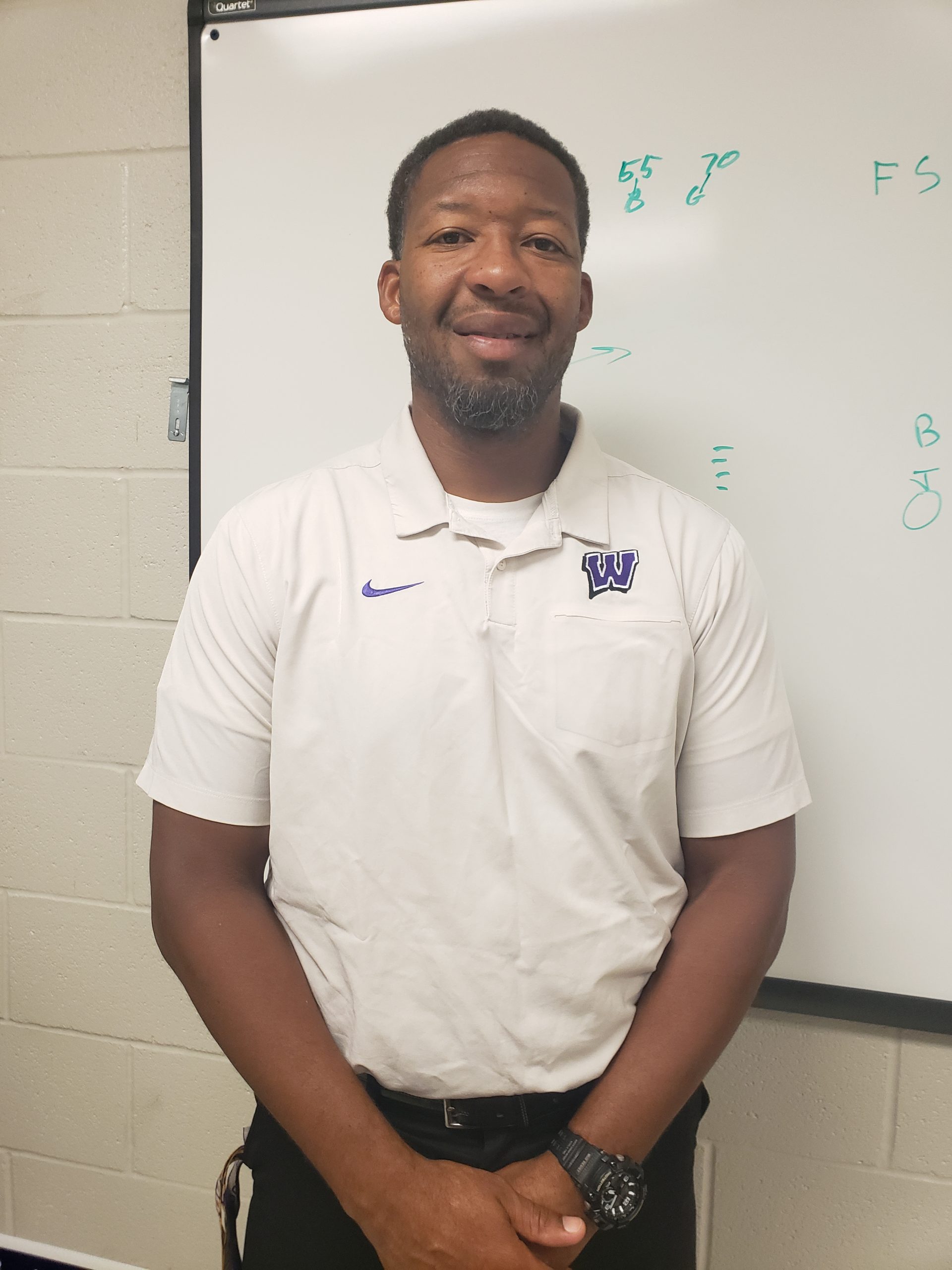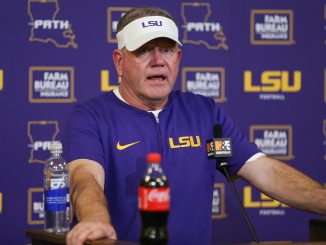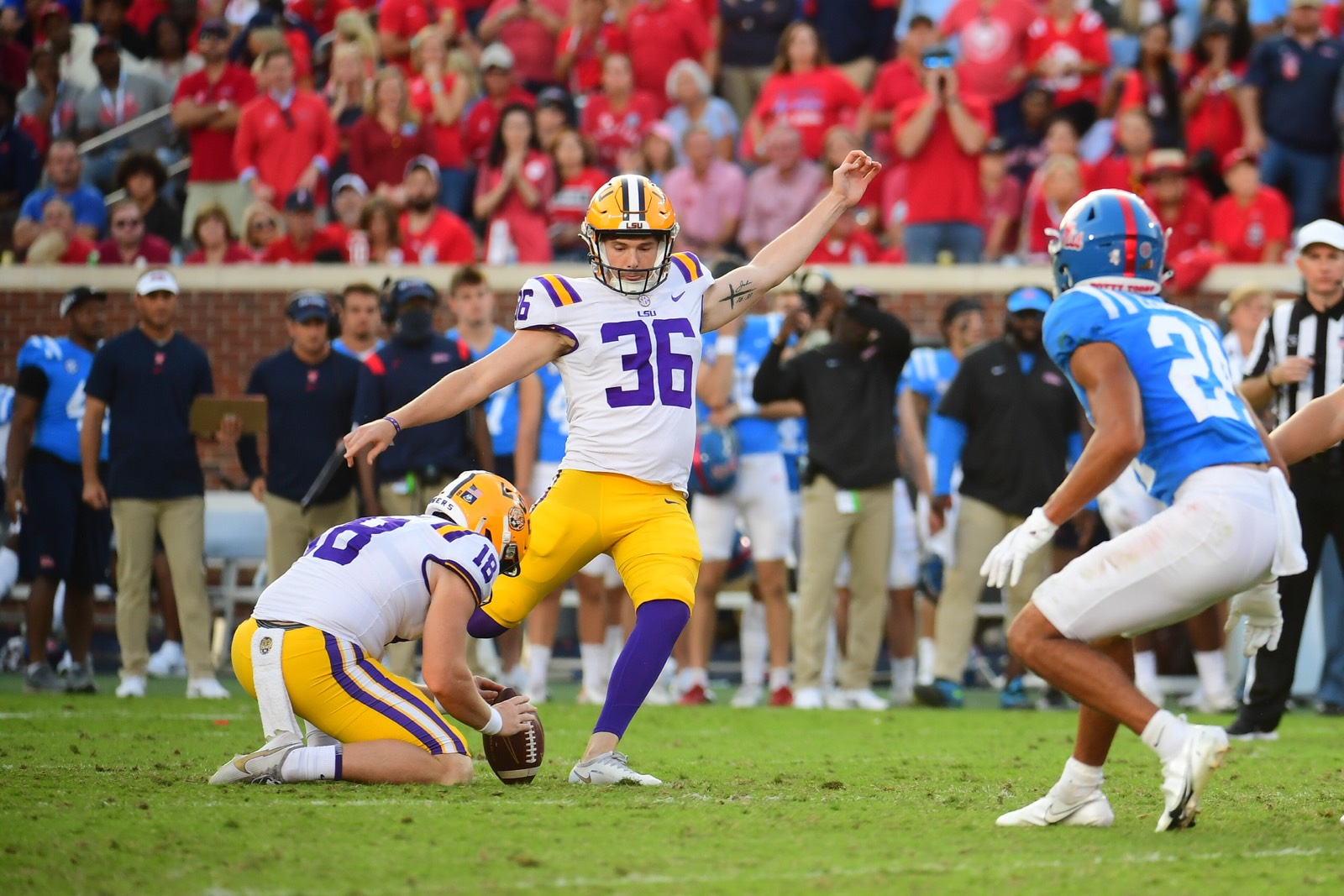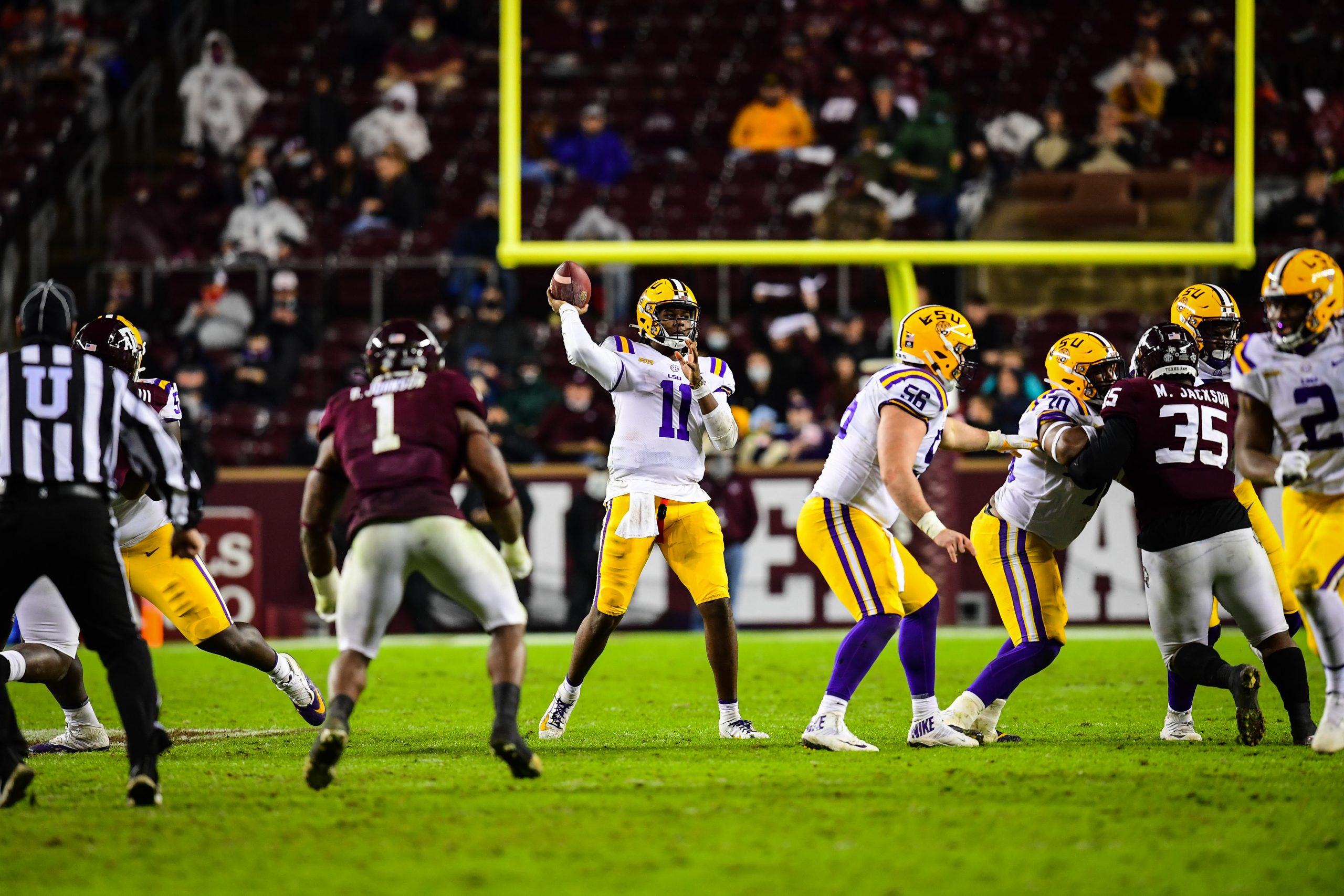
LSU had repeatedly prepared for the moment. Each week, every Thursday the Tigers worked on offensive late-game situations that could arise in a game. Trailing by three points, backed up to their own 8-yard line with 11 seconds remaining, LSU quarterback Marcus Randall and the Tigers found themselves in dire straits at Kentucky’s Commonwealth Stadium on Nov. 9, 2002.
LSU, which seemingly was in control throughout, fell behind 30-27 on a field goal. The backs-to-the-wall scenario drew Randall and the Tigers back to their training under coach Nick Saban where they worked on a play, ‘Dash Right, 93 Berlin’, each Thursday without success.
This time, though, everything aligned just right for LSU to execute one of the more improbable sequences and won 33-30 on the final play of the game. Following the team’s last timeout and with two seconds to play, Randall rolled out to his right and launched a pass from his own 18-yard line. The ball, which was intended down the seam for Michael Clayton, carried beyond, was tipped by several Kentucky defenders and into the waiting hands of LSU’s Devery Henderson who tipped the ball to himself, broke a tackle at Kentucky’s 12 and completed the 74-yard touchdown catch.
Tiger Rag assistant editor William Weathers caught up with Randall at the end of September for an extensive Q&A:
TIGER RAG: What’s it like to be part of one of the schools most memorable plays in LSU history? Does it seem that long atgo?
MARCUS RANDALL: “It really doesn’t seem that long ago. We talk about it almost every year around this time. People love to reminisce, especially here in the South. People love to reminisce, and football will allow you the chance to reminisce about a lot of good times. People can tell you exactly where they were, and I’ve gotten so many of those over these last 20 years. I’ve heard gobs of stories from people who said they missed it, or how they didn’t think it would happen. You tie into a lot of people’s memories of the game. That’s a great thing for people to know me for that and have a part of their memory tied to that.”
TR: How much did you watch the replay of the game?
MR: “I think the first few years, I didn’t really watch it as much. But I think now on Facebook every year, somebody’s talking about the pass or talking about posting it on Facebook and all those different things as well. I sit and watch now and how it ties into different things right now. At the LSU-Southern game, they did my brother’s highlights (former Southern quarterback Eric Randall), and that play was one of my highlights. That’s a great feeling to be a part of the university in that manner.”
TR: When did you realize it was among the school’s most memorable plays?
MR: “I knew coming into LSU and knowing about the Billy Cannon run. I knew about the ‘Earthquake Game’, I knew about beating No. 1 Florida with Herb Tyler. Those are dates in LSU history that kind of stuck out. Being part of the Bluegrass Miracle as a sophomore, then coming back and being part of the national championship, those are just big moments that I was able to be a part of while at LSU that will live on way past me.”
TR: Did the team really practice such plays each week during your career?
MR: “On Thursdays, we went through a lot of situations that may come up in a game and two-minute (drill) was one of them. We would do a normal two-minute where if we had two timeouts or no timeouts. We had to try and drive down and score, get a field goal or whatever coach Saban said the situation called for. We would always have our shot plays for at the end, and we knew exactly what play we were going to run like the first play we threw to (Michael) Clayton over the middle. If we didn’t have a timeout, you probably wouldn’t have seen us run that play, it would have been another play where we run the two outside guys and throw to the No. 3 guy so he could catch it and get out of bounds. We knew what the exact series of plays would be for those situations. Usually, the play to Clayton is us already being at the 40-50 so we can make the throw into the end zone and make the catch. We got the first catch to Michael and the timeout, and I could hear Jimbo Fisher on the headset with Nick Saban telling him the play would be Dash Right 93 Berlin, so we knew that would be the play. I dashed out to the right and set up and gave them time to get all the way down the field, and then just launched it up there so they could make the tip. Michael Clayton was always my aiming point. I aimed to do that in practice all the time, but guys like (defensive backs) Corey Webster, Travis Daniels knocked it down. That day, everything fell into place. It worked perfect. It was magic. When preparation meets opportunity, good luck will happen.”
TR: The play never worked in practice?
MR: “Never worked. Never did we catch it, maybe my whole five years of being at LSU. Even after that there were several plays, we worked on for the same situation.”
TR: Anything you recall before taking the field for that last series?
MR: “It was the last play, and they (Kentucky students) were already hanging from the goalposts.
We were on the sideline in shock. We were pretty much in control the whole game. We were in shock.
They scored two or three touchdowns real quickly and we found ourselves in this position. We knew
what the play was and I saw we still had to go and give it 110%. That’s what we believed in, playing for
60 minutes was our motto. We knew we had to go 100% even if we thought it was far-fetched or it was
out of our range. We knew we would run the play. Devery (Henderson) was one of those guys who could get behind a whole defense and the tip came and went right into his hands.”
TR: What was the huddle like before the final play?
MR: “A lot of us felt we shouldn’t have even been in that situation. It was an early (11 a.m.) game. We were looking around. It didn’t feel good at that time. Just went out there and still gave it our all. It was a miracle.”
TR: What was your angle on the play after you threw the ball?
MR: “I never actually saw the catch. I’m aiming for Michael Clayton, and I saw he got up and maybe he tipped it. There are guys from Kentucky, and it ricocheted off of someone in that moment and Devery is behind all of that. I never saw the catch. I’m looking, I saw him running but I’m still thinking he didn’t have the ball. I didn’t see it. I saw our whole sideline start to rush the field and I’m like, ‘man, he caught it’. I’m seeing people hanging from the goalposts. There are a lot of things I see as the ball’s going and I’m looking up. I’m not seeing him with the ball and then the whole sideline rushed the field.”
TR: Any special moments after the celebration?
MR: “We were shocked to even be in that situation. To make that play at the end, everybody’s going from down to feeling such a high so fast. It was almost crazy, almost like a dream. You have those moments where you’re in your backyard, the clock’s running down from five, four, three and you throw it up and you catch the Hail Mary pass for a touchdown. To live out one of those and be a part of it was a dream.”
TR: The team’s season didn’t take off after such a dramatic ending. What happened?
MR: “We came off a big win at Florida and then I got my first start after Matt Mauck
went down. We had a lot of young guys that season and went to the Sugar Bowl
and beat Illinois. Then the next year you saw us take a big leap and win the
national championship. A lot of guys got to play and learn and gained momentum that year (2002) into the next year.”
TR: You spent an up and down 2002 season until the Kentucky game?
MR: “I had an ACL injury in the spring and actually made it back for the first game against The Citadel.
I played and felt OK and rotated in a couple of other games. Then I came in after the Florida game and started the rest of that season. That was a turning point for that season.”
TR: Has the Bluegrass Miracle been a teaching point in your seven years as a head coach?
MR: “I use the same thing. If there’s still time left on the clock, you’ve got to play. In our (Sept. 23) game against E.D. White (29-26 win), we’re down 20-0 and things are looking down. At halftime I told them they would have to go out and play flawless to have a chance. You always want to be able to use that and for it to be tied to a story in life. I don’t have to use anyone else’s story. I can use my own experience that I lived through is a story that’s second to none.”
TR: Is there much reminiscing over the Bluegrass Miracle?
MR: “Always. They get asked about the same the way I get asked about it. We can
all compare stories like (Randall) Blue (Gaye), Mike Clayton and Devery. All of us came from pretty much this area and were part of Nick Saban’s first couple of (recruiting) classes that helped put LSU on the map. We got it started in our minds.”
TR: How has the association with that play changed your life?
MR: “I’m able to be identified quickly through that play, especially around here. Pretty much anyone with LSU ties, they actually know me from that play. They lived through it and have told their kids about it. I was at a tailgate for the Southern-LSU game, there were kids I know weren’t living then, but they knew about the play. That’s a cool thing.”
TR: What was your role on national championship team a year later?
MR: “If we wouldn’t have been winning, it probably would have been different. We were winning. I wasn’t playing that much in the same role to end the 2002 season. I played when we were beating teams. We were all tight-knit and I know that’s what builds great teams. I know if you’ve got that, it doesn’t matter about the other stuff. When you find good teams, championship-type teams, they know how to put the team first even if a player doesn’t feel like he’s the guy or whatever. I knew I had to be prepared, just like the year before. I knew if anything was to happen, I had to be ready to play.”
TR: What was it like to adapt to playing defense in the NFL?
MR: “I grew up playing multiple positions. I played offensive line, defensive line, running back. I played some quarterback growing up, but not much. I was just an all-around player. It wasn’t until my junior year in high school where I started playing quarterback. As a freshman, I was a safety and running back pretty much my sophomore year and then I played quarterback through college. When I got to Tennessee (Titans), I was still playing quarterback then. They decided they didn’t want a third-string quarterback but wanted to keep me because I did work out at my Pro Day at safety because some teams wanted to see if I could move. I decided if they were going to sign me, they must want me to do it. Then I went to Green Bay, and they wanted to see if I could play (weak side) linebacker, play a little closer to the box. All of that’s helped me now as a coach because I learned so many new things playing the defensive positions those three years. What I thought I was reading as a quarterback, I learned what a defense fully looks like, what their rules are and how they’re reading people. I learned a bunch of things and playing special teams. That’s all helping me now. I can go out and coach any position on the field and not only coach it but understand.”
TR: Any role models you’ve followed into coaching?
MR: “All of my coaches have inspired me to do what I’m doing. I remember leaving that academic center LSU and having thoughts. I was learning so much thinking if I had half of this knowledge going into college, how much further along I would have been. I started to grasp a whole lot of things, but it was on the back end of my playing career. I had gotten my degree, came back and got my teaching certificate and started coaching and that’s what I’ve been doing.”
TR: How proud are you of the Randall Passing Academy?
MR: “When I came back (from the NFL), the big talk was Louisiana has a lot of good athletes, but they can’t produce quarterbacks. Now that I was back coaching, I thought how could we produce quarterbacks if we don’t have that many quarterbacks around here to teach them? If nobody’s giving them the lessons? I saw different guys coming into college like Rick Clausen who already played in 7-on-7s since they were young, and I didn’t even think that was a thing yet in 2005. That’s kind of when we started it in small groups. We took about 16 and started doing it. We’re starting to take it bigger. We’ve been able to touch guys like (UL-Lafayette’s) Levi Lewis, give them a boost. We’re touching people that wanted to work out. It goes back to people saying Louisiana wasn’t producing any quarterbacks. They have to be doing stuff like this. I go to little league games and no one’s really throwing, they’re just giving it to the best player. How are they going to get the reps? How are they going to learn it? A lot of it I had to start learning in college with Jimbo Fisher. I can show a guy like (LSU commitment of Woodlawn) Rickie’s (Collins) is going to have those things. He’ll be able to go out there and read pass protections, knows where his hot receivers are.”




Be the first to comment